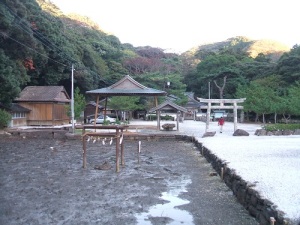◆ Tsushima, the gateway to the Eurasian continent, has become a base for disseminating peace projects - Current status of Tsushima, a border island -
Following the installation of a slanted tunnel entrance last summer, the construction work in Tsushima will extend the tunnel entrance by 10 meters and improve the environment for electricity and water. is needed and is currently waiting for it to be prepared.
From Waniura, the northernmost point, Busan, South Korea can be easily seen within 40km. Since the Yayoi period until today, Tsushima has been the main route connecting Japan to the peninsula and continent, and has been ``National Highway No. 1'' so to speak. This is because even a small boat could reach the island safely if it sailed along the coast. It seems that out of an adventurous spirit to see the shadows of islands that could be seen in the distance, people carefully read the weather and wind, and frequently traded in small boats.
The so-called ``Weishi Wajinden'', written by Chen Shou during the Romance of the Three Kingdoms period, accurately describes Tsushima in 200 characters. However, for us Japanese people, we are most interested in the phrases ``Yamataikoku'' and ``Himiko'' that appear later, and they create an irresistible romantic feeling for ancient history fans. Watatsumi Shrine is also the shrine where Yamasachihiko is said to have met his wife Toyotamahime, the daughter of the sea god, and whose grandson was Emperor Jinmu, who is said to be the first emperor. The torii gate extends from the sea and leads to the main shrine, and when the tide comes in, the sea water flows into the shrine grounds.
The waterway here is the way Toyotama Hime comes to land from her underwater royal palace. At its end, there is a ``three-legged torii gate'' that leads to the main shrine. ``Kojiki'' tells the story of ancient Japan's nation-building, and the scene comes back to mind. Tsushima is truly an island full of historical romance.
[Photo] View of Busan from the Korea Observatory in Waniura, the northernmost tip of Tsushima. Yellow sand and PM2.5 blur the horizon.
Next to Watatsumi Shrine is Mt. Eboshi. You can enjoy a 360-degree view of the island from the mountaintop observation deck. Tsushima is like a string of small mountains connected together. The depressed sea created by mountain-building activities known as Drone Valley creates a complex coastline, and the suddenly deepening sea breeds large fish. There is little flat land, so airports have to be built on top of mountains, making it difficult to take off and land when the wind is strong.
The natural environment of Tsushima is created by combining the everlasting summer of Hawaii with the dramatic changes of the four seasons. It is an island with beautiful blue skies and sea. Of course, only those who have tasted it can appreciate the deliciousness of the firm seafood grown in the fast-flowing Tsushima Current. "Kanburi" is a specialty product.
Each small mountain or Mt. Cobu has a torii gate at its base. There is a shrine where the mountain is the object of worship, and the simple faith in the mountain is alive and well. There is the appearance of an ancient shrine, and then there is "Amateru Shrine". It's a word that makes you think of "Amaterasu." Tsushima is an island that is worshiped by the sun, and is paired with Iki, which is worshiped by Tsukuyomi and the moon. The three gods with the addition of Susanoo are the three gods that Izanagi and Izanami gave birth to at the end of the birth of the country.

[Photo] "Watatsumi Shrine" The three-legged torii gate has a hidden historical romance
Tsushima's history includes important events such as many ruins from the Yayoi period, Mongol invasions during the Kamakura period, Korean envoys during the Edo period, and the Russo-Japanese War during the Meiji period. However, today, in the Pacific era, with America-centered diplomacy, it seems as if it has been forgotten. As many as 180,000 tourists from South Korea visit here each year, and the streets of Izuhara, the city center, are buzzing with Hangul.
Because there are few Japanese tourists, the tourism industry such as inns and hotels is managing to survive. Furthermore, in addition to the population decline due to young people leaving the island for jobs due to the lack of industry, the island is also experiencing the effects of the declining birthrate and aging population. The same phenomenon is occurring in Iki, which I covered last time. Tsushima is more than just a border island. In today's world, when it seems that trade with the world has shifted to the sea and air, there is no doubt that land routes are trade routes that can bring about deep friendships and peace.
In that sense, the ``International Highway'' that connects Japan from the peninsula to the Eurasian continent, and its starting points, the ``Japan-Korea Tunnel'' and the ``Bering Strait Tunnel,'' can be said to be a project to create a new culture. Is it too much to say that the concepts of "land routes" and "land connections" will create a new Japan?